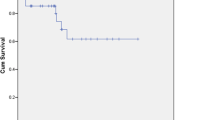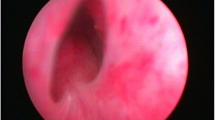Abstract
Posterior urethral valves (PUV) associated with renal dysplasia are one of the most common causes of end stage kidney disease (ESKD) in childhood. In order to identify risk factors for the progression of this condition to early renal failure, we have retrospectively analyzed the clinical course, renal function, and first postnatal renal ultrasound in a sample of 42 young male patients with PUV, who were followed at a single center. Twelve (28.6%) were diagnosed with ESKD at a median age of 11.3 years. Our comparison of PUV patients without decreased estimated glomerular filtration rate (eGFR) (group A; K/DOQI CKD stage 0–1) with PUV patients showing a decreased eGFR (group B; K/DOQI CKD stage 2–5) revealed the following significant risk factors for loss of eGFR: renal volume <3rd percentile (P < 0.001), elevated echogenicity (P = 0.001), pathologic corticomedullary differentiation (P < 0.001), >3 febrile urinary tract infections (P = 0.012), and decreased eGFR at 1 year of age (P < 0.001). Receiver operating characteristic curve analysis in the cohort confirms that patients showing a renal volume >88.2 ml/m2 body surface area (BSA) are not at risk to develop K/DOQI CKD stage 5 (sensitivity 75%, specificity 77.3%, positive/negative predictive value 37.5/94.4%). Ultrasound promises to be a valuable tool for identifying endangered patients.




Similar content being viewed by others
Abbreviations
- K/DOQI:
-
Kidney Disease Outcomes Quality Initiative
References
Atwell JD (1983) Posterior urethral valves in the British Isles: a multicenter BAPS. J Pediatr Surg 18:70–74
Opsomer R, Wese F, Dardenne A, Van Cangh P (1990) Posterior urethral valves in adults males. Urology 36:35–37
Duckett JW (1974) Current management of posterior urethral valves. Urol Clin North Am 1:471–483
Agarwal S (1999) Urethral valves. BJU Int 84:570–578
Frei U, Schober-Halstenberg HJ (2007) Nierenersatztherapie in Deutschland, Bericht über Dialysebehandlung und Nierentransplantation in Deutschland. Bundesverband Niere e.V. Available at: http://www.bundesverband-niere.de/files/QuaSi-Niere-Bericht_2006-2007.pdf
Smith GH, Canning DA, Schulman SL, Snyder HM 3rd, Duckett JW (1996) The long-term outcome of posterior urethral valves treated with primary valve ablation and observation. J Urol 155:1730–1734
Ylinen E, Ala-Houhala M, Wikstrom S (2004) Prognostic factors of posterior urethral valves and the role of antenatal detection. Pediatr Nephrol 19:874–879
Bajpai M, Dave S, Gupta DK (2001) Factors affecting outcome in the management of posterior urethral valves. Pediatr Surg Int 17:11–15
Tejani A, Butt K, Glassberg K, Price A, Gurumurthy K (1986) Predictors of eventual end stage renal disease in children with posterior urethral valves. J Urol 136:857–860
Oliveira EA, Rabelo EA, Pereira AK, Diniz J, Cabral A, Leite HV, Silva J, Tiago F (2002) Prognostic factors in prenatally-detected posterior urethral valves: a multivariate analysis. Pediatr Surg Int 18:662–667
Lopez Pereira P, Espinosa L, Martinez Urrutina MJ, Lobato R, Navarro M, Jaureguizar E (2003) Posterior urethral valves: prognostic factors. BJU Int 91:687–690
Hutton KAR, Thomas DFM, Davies BW (1997) Prenatally detected posterior urethral valves: qualitative assessment of second trimester scans and prediction of outcome. J Urol 158:1022–1025
Denes ED, Barthold JS, Gonzales R (1997) Early prognostic value of serum creatinine levels in children with posterior urethral valves. J Urol 157:1441–1443
Parkhouse HF, Barratt TM, Dillon MJ, Duffy PG, Fay J, Ransley PG, Woodhouse RJ, Williams DI (1988) Long-term outcome of boys with posterior urethral valves. Br J Urol 62:59–62
Duel BP, Mogbo K, Barthold JS, Gonzalez R (1998) Prognostic value of initial renal ultrasound in patients with posterior urethral valves. J Urol 160:1198–1200
Sarhan O, Zaccaria I, Macher MA, Muller F, Vuillard E, Delezoide AL, Sebag G, Oury JF, Aigrain Y, El-Ghoneimi A (2008) Long-term outcome of prenatally detected posterior urethral valves: single center study of 65 cases managed by primary valve ablation. J Urol 179:307–313
Rittenberg MH, Hulbert WC, Snyder HM, Duckett JW (1988) Protective factors in posterior urethral valves. J Urol 140:993–996
Lebowitz RL, Olbing H, Parkkulainen KV, Smellie JM, Tamminen-Mobius TE (1985) International system of radiographic grading of vesicoureteral reflux. International Reflux Study in Children. Pediatr Radiol 15:105–109
Dinkel E, Ertel M, Dittrich M, Peters H, Berres M, Schulte-Wissermann H (1985) Kidney size in childhood. Sonographical growth charts for kidney length and volume. Pediatr Radiol 15:38–43
Beetz R, Bökenkamp A, Brandis M, Hoyer P, John U, Kemper MJ, Kirschstein M, Kuwertz-Bröking E, Misselwitz J, Müller-Wiefel DE, Rascher W (2001) Diagnosis of congenital dilatation of the urinary tract. Consensus Group of the Pediatric Nephrology Working Society in cooperation with the Pediatric Urology Working Group of the German Society of Urology and with the Pediatric Urology Working Society in the Germany Society of Pediatric Surgery. Urologe 40:495–507
Schwartz GJ, Haycock GB, Edelmann CM, Spitzer A (1976) A Simple estimate of glomerular filtration rate in children derived from body length and plasma creatinine. Pediatrics 58:259–263
National Kidney Foundation (2002) K/DOQI clinical practice guidelines for chronic kidney disease: evaluation, classification and stratification. Am J Kidney Dis 39:S1–S266
Holmes N, Harrison MR, Baskin LS (2001) Fetal surgery for posterior urethral valves: long-term postnatal outcomes. Pediatrics 108:e7
Clark TJ, Martin WL, Divakaran TG, Whittle MJ, Kilby MD, Khan KS (2003) Prenatal bladder drainage in the management of fetal lower urinary tract obstruction: a systematic review and meta-analysis. Obstet Gynecol 102:367–382
Yohannes P, Hanna M (2002) Current trends in the management of posterior urethral valves in the pediatric population. Urology 60:947–953
Schober JM, Dulabon LM, Woodhouse CR (2004) Outcome of valve ablation in late-presenting posterior urethral valves. BJU Int 94:616–619
Klaassen I, Neuhaus T, Mueller-Wiefel D, Kemper M (2007) Posterior urethral valves: prenatal diagnostic signs and outcome. Nephrol Dial Transplant 22:432–439
Schwartz G, Furth S (2006) Glomerular filtration rate measurement and estimation in chronic kidney disease. Pediatr Nephrol 22:1839–1848
Ansari MS, Singh P, Mandhani A, Dubey D, Srivastava A, Kapoor R, Kumar A (2008) Delayed presentation in posterior urethral valve: long-term implications and outcome. Urology 71:230–234
Drozdz D, Drozdz M, Gretz N, Möhring K, Mehls O, Schärer K (1998) Progression to end-stage renal disease in children with posterior urethral valves. Pediatr Nephrol 12:630–636
Bartsch L, Sarwal M, Orlandi P, Yorgin PD, Salvatierra O (2002) Limited surgical interventions in children with posterior urethral valves can lead to better outcomes following renal transplantation. Pediatr Transpl 6:400–405
Author information
Authors and Affiliations
Corresponding author
Rights and permissions
About this article
Cite this article
Pohl, M., Mentzel, HJ., Vogt, S. et al. Risk factors for renal insufficiency in children with urethral valves. Pediatr Nephrol 27, 443–450 (2012). https://doi.org/10.1007/s00467-011-1999-2
Received:
Revised:
Accepted:
Published:
Issue Date:
DOI: https://doi.org/10.1007/s00467-011-1999-2




